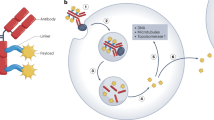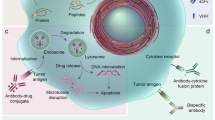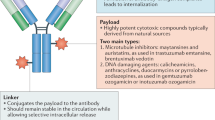Abstract
THE possibility of using cytotoxic drugs linked to tumour-specific antibodies as a form of cancer chemotherapy has been revived recently. In theory the antibodies would selectively transport the drugs to the target tumour site. The demonstration by Ghose et al.1,2 and also by Flechner3 that chlorambucil and antibody combined produce an augmented antitumour effect can, however, be explained by an additive or synergistic effect of drugs and antibody uncombined, since there is a high probability of in vivo dissociation4–6. Although this synergistic drug–antibody effect has been studied in detail7–9, the original aim of preparing a stable drug–antibody conjugate has also been pursued and evidence of in vivo tumour suppression has been obtained with covalent conjugates of rabbit antitumour immunoglobulin (Ig) and alkylating agents10,11. In these studies, direct conjugation of the drugs with Ig was carried out using a water-soluble carbodiimide. Successful tumour suppression was, however, dependent on using large amounts of linked material since severe limitations are imposed on the degree of drug substitution by the physico-chemical changes induced in the immunoglobulin by linkage. These changes are reflected in loss of antibody activity and poor water solubility of the preparations thus limiting the clinical potential of complexes in this form. Here we describe a method of overcoming these problems. Instead of direct substitution of the drugs on the Ig, an intermediate carrier molecule is heavily substituted and the drug carrier then linked to Ig. By minimising interference with the chemical structure of Ig in this linkage step, a conjugate is produced with both a high concentration of drug and little loss of antibody activity. This conjugate has proved effective in suppressing tumour growth in mice.
This is a preview of subscription content, access via your institution
Access options
Subscribe to this journal
Receive 51 print issues and online access
$199.00 per year
only $3.90 per issue
Buy this article
- Purchase on Springer Link
- Instant access to full article PDF
Prices may be subject to local taxes which are calculated during checkout
Similar content being viewed by others
References
Ghose, T., et al., Br. med. J., 3, 495–499 (1972).
Ghose, T., and Nigam, S. P., Cancer, 29, 1398–1400 (1972).
Flechner, I., Eur. J. Cancer, 9, 741–745 (1973).
Ross, W. C. J., Chem–Biol Interactions, 8, 261–267 (1974).
Davies, D. A. L., and O'Neill, G. J., Br. J. Cancer, 28, Supp. I. 285–298 (1973).
Rubens, R. D., and Dulbecco, R., Nature, 248, 81–82 (1974).
Davies, D. A. L., Buckham, S., and Manstone, A. J., Br. J. Cancer, 30, 305–311 (1974).
Davies, D. A. L., Cancer Res., 34, 3040–3043 (1974).
O'Neill, G. J., Pearson, B. A., and Davies, D. A. L., Immunology (in the press).
Davies, D. A. L., and O'Neill, G. J., Proc. XI Int. Cancer Congress Florence (1974) (in the press).
O'Neill, G. J., and Davies, D. A. L., Proc. second National Congress of Oncology Bucharest (1975) (in the press).
Silman, H. I., and Sela, M., in Poly-α-amino acids (edit. by Fasman, G. D.), 657 (Edward Arnold, London, 1967).
Epstein, J., Rosenthal, R. W., and Ess, R. J., Analyt. Chem., 27, 1435–1439 (1955).
Davies, D. A. L., Manstone, A. J., and Buckham, S., Br. J. Cancer, 30, 297–304 (1974).
Szekerke, M., Wade, R., and Whisson, M. E., Neoplasma, 19, 199–209 (1972).
Cancer Chemotherapy Reports, 3, No. 2 (1972).
Author information
Authors and Affiliations
Rights and permissions
About this article
Cite this article
ROWLAND, G., O'NEILL, G. & DAVIES, D. Suppression of tumour growth in mice by a drug–antibody conjugate using a novel approach to linkage. Nature 255, 487–488 (1975). https://doi.org/10.1038/255487a0
Received:
Accepted:
Issue Date:
DOI: https://doi.org/10.1038/255487a0
This article is cited by
-
Potential of antibody–drug conjugates (ADCs) for cancer therapy
Cancer Cell International (2022)
-
Emerging combination immunotherapy strategies for breast cancer: dual immune checkpoint modulation, antibody–drug conjugates and bispecific antibodies
Breast Cancer Research and Treatment (2022)
-
Unlocking the potential of antibody–drug conjugates for cancer therapy
Nature Reviews Clinical Oncology (2021)
-
The clinical development of antibody–drug conjugates — lessons from leukaemia
Nature Reviews Clinical Oncology (2021)
-
Rational Design of Biomolecules/Polymer Hybrids by Reversible Deactivation Radical Polymerization (RDRP) for Biomedical Applications
Chinese Journal of Polymer Science (2021)
Comments
By submitting a comment you agree to abide by our Terms and Community Guidelines. If you find something abusive or that does not comply with our terms or guidelines please flag it as inappropriate.



